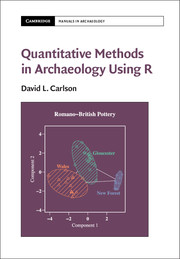16 - Spatial Analysis
from PART III - ARCHAEOLOGICAL APPROACHES TO DATA
Published online by Cambridge University Press: 22 July 2017
Summary
An integral aspect of archaeological data is that they come from particular places. We often want to examine the distribution of artifacts, sites, or features over space and R provides a number of tools for this purpose. We may also be interested in the direction or orientation of the object, house, or feature. This chapter will cover some of the basics, but there are specialized R packages for mapping and for analyzing gridded and point data. If most of your analysis involves spatial data it may be easier to use a geographic information system (GIS) package, but R can handle shapefiles and other data structures that are produced by those packages and it provides extensive support for statistical analysis of spatial data. In this chapter we will cover directional statistics, creating simple distribution maps based on gridded or piece plotted data.
CIRCULAR OR DIRECTIONAL STATISTICS
Circular statistics include direction and orientation (Gaile and Burt, 1980; Jammalamadaka and Sengupta, 2001; Mardia and Jupp, 2000). If we are interested in the direction of something (for example burials or rock shelter openings), then we are using directional data. In general, this is recorded in degrees measured clockwise from north, but it can also include cyclical data where the cycle repeats daily, weekly, monthly, or yearly. In other cases, we are interested in the orientation of an elongated flake, blade, or bone fragment. Orientation can be defined as north/south or east/west so we are only using half of the circle since 0° and 180° or 90° and 270° are the same orientation. With bone fragments, for example, we usually cannot identify which end is the front and which is the back so we are working with orientation. With blades, we could define the platform end as the front in which case we could measure direction rather than orientation, but often only the orientation is recorded. The research question under consideration will help to make the decision between direction and orientation. Analytically, the first step with orientation data is to double each value and analyze it as directional data.
- Type
- Chapter
- Information
- Quantitative Methods in Archaeology Using R , pp. 349 - 378Publisher: Cambridge University PressPrint publication year: 2017



